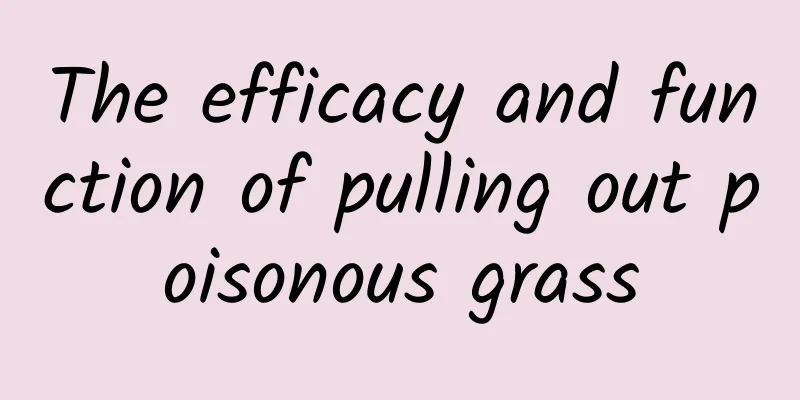The efficacy and function of pulling out poisonous grass

|
The detoxifying grass is a traditional Chinese medicinal material. This type of medicine can cover many aspects of disease treatment, so before choosing the detoxifying grass, you must have a good understanding of it. Let us introduce it in detail below. [Other names] Bone grass, blood-scattering grass [Source] Medicinal material source: the whole herb of Ajuga macrophylla, a plant of the Lamiaceae family. [Original morphology] Large-seeded Ajuga, an erect herb, 15-40cm tall. The stem is quadrangular, grooved, sparsely pubescent, and young parts are densely white and long pubescent. Leaves opposite; petiole 2-5cm long, narrowly winged, sparsely pubescent; leaf blade papery, oblanceolate, ovate-lanceolate or elliptic-ovate, 4-10cm long, 1.8-4.5cm wide, with obtuse or acute apex, cuneate base, decurrent, both sides pubescent or strigose, margin wavy-toothed, ciliate. The cyme has 6-12 flowers, most of which are borne on the middle and upper parts of the stems and branches, gradually becoming denser upwards to form spikes; the lower part of the bracts is the same shape as the stems and leaves, and gradually becomes smaller at the upper part; the calyx is funnel-shaped, with long rough hairs on the veins and calyx teeth on the outside, and glabrous inside, with 10 veins and calyx teeth 5; the corolla is blue, blue-purple or purple, tubular, 7-9mm long, oblique, sparsely pubescent on the outside, with a hair ring near the base on the inside, the rim of the corolla is two-lipped, the upper lip is erect, 2-lobed, the lower lip is elongated, 3-lobed; the stamens are 4, didyna; the style is thin and weak, extending out of the corolla a lot, glabrous, and 2-lobed at the apex; the disk is annular; the ovary is 4-lobed and glabrous. The nutlets are obovate-triangular, with very obvious reticular wrinkles on the back and a navel on the abdomen, which occupies 2/3-3/4 of the ventral surface. The flowering period is from January to March, and the fruiting period is from March to May. [Habitat distribution] Ecological environment: Grown in the shade and wet places under forests, beside ditches and in grass beside roadsides at an altitude of 350-1750m, sometimes up to 2600m. [Properties] The whole plant contains ajugamacrin A, B, C, D, E and ajugapantin A. In addition, there are proline, hydroxyproline, phenylalanine, methionine, tyrosine, valine, glutamic acid, aspartic acid, glycine, fatty acid and unsaturated fatty acid. 【Nature and flavor】 Bitter; pungent; cold 【Functions and indications】 Clears heat and cools blood; disperses blood stasis and relieves pain. It is used for cough due to lung heat, vomiting blood, epistaxis, dysentery, painful stranguria, rheumatic pain, and swelling and pain due to falls. [Usage and Dosage] For oral use: decoction, 6-15g. For external use: take appropriate amount, mash and apply or decoct in water for washing. 【Excerpt】 Chinese Materia Medica The above are some of the basic functions of the detoxifying grass introduced to you, as well as the method of eating the detoxifying grass, so that you will not use it wrongly when eating it, and you can also make better use of the value of the detoxifying grass. |
<<: The efficacy and function of Tiger Orchid
>>: The efficacy and function of fat pig grass
Recommend
What can be stewed with Tianma?
The Chinese herbal medicine Gastrodia elata is ve...
Sweating profusely one second and generating electricity the next, what turns the human body into a generator?
The recent hot weather is really hot. As soon as ...
The efficacy and function of yellow tea root
Yellow tea root is a traditional Chinese medicine...
The efficacy and function of Peruvian balsam gum
I believe many people are familiar with the Chine...
Chinese herbal medicine for cough and phlegm
When people have symptoms of coughing, they can c...
The efficacy and function of Zhu Fushen
The plant Zhu Fushen is not very common, so many ...
The efficacy and function of Angustifolia
Lycopodii angustifolia is a famous traditional Ch...
Wireless charging, say goodbye to the "wired" life!
Wireless charging form There are three types of w...
What are the effects and functions of Xueyu charcoal
Xueyutan is a kind of traditional Chinese medicin...
In late autumn, if you want to "rest", you must know these →
Recently, many places in Beijing, which has enter...
Lemongrass Leaves
Many consumers see compounds such as "citron...
The efficacy and function of bamboo tree
Bamboo tree is a very common type of Chinese medi...
The efficacy and function of arrowhead
Chinese medicine has different effects on our bod...
The efficacy and function of carp scales
As people's research on traditional Chinese m...



![The efficacy and function of Tianxianteng[picture]](/upload/images/67ca0d3da8047.webp)





